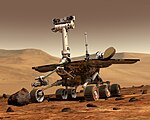Pancam

PanCam is two electronic stereo cameras on Mars Exploration Rovers Spirit and Opportunity.[2] It can view different wavelengths of light and they mounted next to two NavCams.[2]
According to Cornell University it can work with Mini-TES to analyze surroundings.[2]
Optics
The focal length of the camera is 43 mm with a field of view (FOV) of 16° x 16°.[3]
Charge-Coupled Device
A 1024 x 2048 frame transfer Charge-Coupled Device (CCD) detector built by Mitel is used for both cameras. CCD is front side illuminated and does not use any anti reflex or UV-enhancing coatings. Half of the chip is used for storage and readout and is therefore shielded from illumination.[3]
Electronics
An Actel Field Programmable Gate Array (FPGA) RT1280 provides the necessary computational abilities for the camera. The signal of the CCD is transformed into a 12 bit digital signal before data processing.[3]
Filter wheel
The left camera has filters with the following wave length: (739, 753, 673, 601, 535, 482, 432, 440 nm), while the right camera has the filters for:(436, 754, 803, 864, 904, 934, 1009, 880 nm)[3]
Calibration target
The calibration target on the rover is also part of the camera system and contains several areas. Polished areas to reflect the Martian sky, areas with known reflectivity and at the four corners color targets made from silicone. The inorganic pigments for the corners were hematite, goethite, chromium oxide and cobalt aluminate.[3]
See also
References
- ^ NASA - PIA07942
- ^ a b c Athena - PanCam
- ^ a b c d e . doi:10.1029/2003JE002070.
{{cite journal}}: Cite journal requires|journal=(help); Missing or empty|title=(help)
